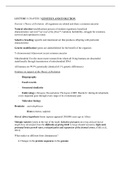Summary
Summary Biological Psychology (Chandler book + lecture notes)
- Course
- Institution
- Book
This summary includes all the information covered in the lectures and mandatory reading materials from the Chandler book. To help you study better, the summary has a clear, straight to the point structure, images and tables.
[Show more]




